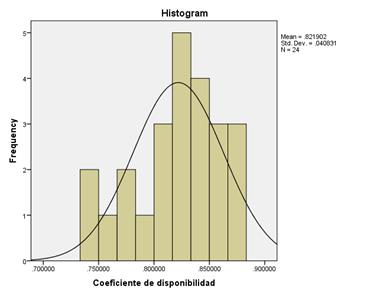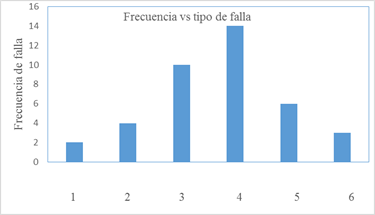INTRODUCTION
In recent decades there have been worldwide increases in the mechanization of grain crops to increase productivity, due to the growth of the sown areas and the short amplitude of the time of harvest. Brazil is the world's largest producer of grains with more than three million tons per year according to Campos et al. (2016), with agricultural yields ranging from one to two t/ha (Moreira et al., 2013). In Cuba, production does not satisfy demand and this forces imports. The introduction of modern machines has increased the harvesting capacity of Cuban agriculture. In the province of Ciego de Ávila the Massey Fergunson 5650 harvesters do not reach the expected productivity
When referring to the productivity of grain harvesters, Pérez et al. (2014) explain that in the last instance it is determined by the maximum feeding in the threshing system, that is to say, by the capacity of feeding of the combined. That depends on the type and dimensions of the threshing structures and work regime, its regulations, crop conditions, engine power, surface conditions of the field in harvest, among others.Miranda et al. (2013) points out that the use of the shift time of the harvesters shows a great reserve of the increase in productivity. Agricultural yields influence both the speed of the machine and its productivity, in Cuba bean agricultural yields are reported variable between one and three t/ha (Chacón, 2012; Maqueira et al., 2016; González-Rojas et al., 2017).
Iglesias et al. (2012) refer that in Cuba, there are several factors affecting the harvest of grains. They are excessive weeding, action of microorganisms, deficiency in the planning of the harvest and different regulations of the threshing structures. Miranda et al. (2016), highlights the importance of an adequate productivity of the harvester for a low energy cost per processed mass. One of the factors that most affects productivity is the reliability of the machine. Several authors have characterized the exploitation reliability coefficient using different variants (González-Rojas et al., 2017). For New Holland TC-57 they report values from 0.58 to 0.62 considering the time invested in the management and search of the pieces and from 0.82 to 0,83 without considering that time.Miranda et al. (2015), obtained for CLAAS Dominator harvester, values of 0.92 for the chronometric variant and 0.87 for the cost variant. This suggests the need to improve the technological discipline in carrying out technical maintenance operations and have the necessary parts, instruments and devices for these operations. The evaluation of the productivity of the grain harvesters in the conditions of Ciego de Ávila province will allow the producers to know the performance of their machines, as well as the factors that can be improved to increase their productive efficiency. Hence, the objective of this work was to evaluate the factors that affect the productivity of these harvesters, evaluating the use of shift time, technical availability and the main faults.
METHODS
The balance of shift time is an important tool to evaluate the harvest-transport process of grains, the rational use of clean working time and those that affect productivity (Iglesias et al., 2012). Measurements of the area worked and the mass of grains in the unit of time allows us to determine the productivity of the harvesters as well as the agricultural yield.
where:
Wh |
- Hourly productivity, t / h. |
B |
- Labor front, m. |
β |
- Coefficient of use of the work front. |
Vtr |
- Working speed, km / h. |
U |
- Agricultural yield, t / ha. |
Kexp |
- Coefficient of use of shift time. |
Maintenance is a key factor in increasing productivity, reducing the number of stops, decreasing costs and making machines work correctly, according to specifications (Herrera et al., 2012). Hence, determining the main failures and their causes is a decisive step to achieve that goal. The identification of faults and faults can be conducted with different philosophies or work strategies according to Shkiliova y Fernández (2011): proactive maintenance, predictive maintenance, corrective maintenance and maintenance engineering.
This suggests a systematic follow-up of the reliability indicators to keep the equipment in the predictive field. Another feature highlighted by Herrera et al. (2012), as a very important one to maintain high availability is the maintainability of the machine (with the training and resources necessary for maintenance). Regarding the technological process of the harvesters, Cassia et al. (2015), comment that the techniques of real-time monitoring of the harvest allow interacting with the different systems of the machine that determine their productivity and quality of harvest.
Several authors have studied the availability of harvesters as a cause of low yields. The Kd technical availability coefficient correctly describes the level of performance of the machine depending on its reliability (De la Cruz et al., 2013; Uttaro et al., 2015):
RESULTS AND DISCUSSION
Chronometer measuring through photos of the process was developed in 24 days. For the statistical analysis, the Excel and SPSS version 21 tools were used. The value of the shift time coefficient was under 0.69. The productivities of the harvester (Table 1) may also be higher, so work must be done on aspects such as reduction of auxiliary times, better preparation of the field for harvesting, updated history of element changes and maintenance performed on the machine, training of operators, improving of technological processes and maintenance operations of grain harvesters.
The statistical treatment of the productivities appears in Table 1.
TABLE 1 Statistical analysis of productivities
| Variable | Mean | Error | Standard Deviation | Skewness | Kurtosis |
|---|---|---|---|---|---|
| Agricultural Performance t/ha | 1,1500 | 0,00949 | 0,03795 | 0,402 | -1,598 |
| Hourly productivity ha/h | 1,8663 | 0,05976 | 0,23902 | -1,585 | 6,854 |
| Hourly productivity t/h | 1,6231 | 0,05374 | 0,21496 | -0,836 | 5,577 |
| Daily Productivity t/jor | 11,7419 | 0,57219 | 2,28878 | -2,113 | 3,987 |
In the statistical treatment, acceptable values were obtained for the means of productivities and less concentrated values of agricultural yields.
The coefficient of technical availability (Figure 1) of average 0.82, still has a good reserve to improve the performance of the harvesters, their hourly performance and reduce operating costs.
To analyze the faults (in which 39 were presented), it is important to consider aspects such as: system where the failure occurs, impact and causes of it. The frequency of occurrence of the fault indicates the level of prevention and ability to restore the failure that each element requires. Most frequent failures: three and four, faults in the cutting system and failures in the harvesting system. The observed faults were: (Figure 2).
Failure in the capacity of the brake system.
Failures in the hydraulic system.
Failures in the cutting system.
Failures in the harvest system.
Failures in the air conditioning system.
The electrical system fails.
CONCLUSIONS
The productivity of the harvesters can be increased by reducing the losses of time during the day, improving the conditions of the field for the harvest and achieving higher agricultural yields.
The coefficient of technical availability still has reserves for its increase, which can be achieved by improving the organization, quality and control of maintenance operations so that it is preventive if the most frequent failures of the harvesters are known.











 texto en
texto en 







